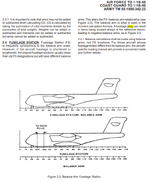To expand a bit on the clear definition provided by rb1957, here is a bit of real world example. Boeing uses a special numbering system to identify the fuselage inserts. They do this (I guess, I am not Boeing) so that the major aircraft components such as landing gear, engines, wings, stabilizers, flight controls, etc., remain at the same station location and only the fuselage inserts have the special numbering scheme.
To the example for which I am quite familiar by experience:
For the Boeing NG (Next Generation series 737-600/700/800/900) the baseline aircraft with no fuselage inserts is the 737-600. To stretch to the 737-800 with which I am most familiar, Boeing installed a fuselage insert forward of the wings and another fuselage insert aft of the wings.
For the forward insert, they "sliced" the aircraft apart at frame station 500 (STA 500 in abbreviated parlance). From STA 130 (nose of the aircraft is 130" aft of the datum, thus there are no stations 1 thru 129 on the aircraft) thru STA 500, the station locations still match the actual inches from the datum. They install a 198" long fuselage insert consisting of nine 22" frame stations. The new frame stations are labeled STA 500A, STA 500B, STA 500C, STA 500D, STA 500E, STA 500F, STA 500G, STA 500H and STA 500I which then rejoins the aircraft. So for example the new location of STA 520 is actually 520" from the datum PLUS the new 198" fuselage insert. Therefore STA 520 is now 718" aft of the datum. STA 540 is 540" PLUS 198" or 738" aft of the datum, etc.
Something similar occurs with the aft fuselage insert where the aircraft is "sliced" at STA 727 but because of the forward fuselage insert STA 727 is actually 727" PLUS 198" from the datum, or 925" from the datum. Since the aft fuselage insert is 212" long, every station aft of the aft fuselage insert is 198" PLUS 212" added to the STA number to determine the location aft of the datum.
This is likely more detail than you wanted, but if you have to do any design work on Boeing aircraft with fuselage inserts, you will want to get familiar with this information. It usually can be found in the Boeing SRM Chapter 53, Boeing AMM Chapter 6 and Boeing centerline drawings, if you have access.

